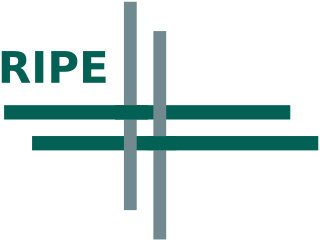
HTTP is an application layer protocol in the Internet protocol suite model for distributed, collaborative, hypermedia information systems. HTTP is the foundation of data communication for the World Wide Web, where hypertext documents include hyperlinks to other resources that the user can easily access, for example by a mouse click or by tapping the screen in a web browser.

The Internet Engineering Task Force (IETF) is a standards organization for the Internet and is responsible for the technical standards that make up the Internet protocol suite (TCP/IP). It has no formal membership roster or requirements and all its participants are volunteers. Their work is usually funded by employers or other sponsors.

Software architecture is the set of structures needed to reason about a software system and the discipline of creating such structures and systems. Each structure comprises software elements, relations among them, and properties of both elements and relations.

Réseaux IP Européens is a forum open to all parties with an interest in the technical development of the Internet. The RIPE community's objective is to ensure that the administrative and technical coordination necessary to maintain and develop the Internet continues. It is not a standards body like the Internet Engineering Task Force (IETF) and does not deal with domain names like ICANN.
The Internet Architecture Board (IAB) is "a committee of the Internet Engineering Task Force (IETF) and an advisory body of the Internet Society (ISOC). Its responsibilities include architectural oversight of IETF activities, Internet Standards Process oversight and appeal, and the appointment of the Request for Comments (RFC) Editor. The IAB is also responsible for the management of the IETF protocol parameter registries."
Senior management, executive management, or upper management is an occupation at the highest level of management of an organization, performed by individuals who have the day-to-day tasks of managing the organization, sometimes a company or a corporation.

The 3rd Generation Partnership Project (3GPP) is an umbrella term for a number of standards organizations which develop protocols for mobile telecommunications. Its best known work is the development and maintenance of:
An organizational structure defines how activities such as task allocation, coordination, and supervision are directed toward the achievement of organizational aims.
Departmentalization refers to the process of grouping activities into departments. Division of labour creates specialists who need coordination. This coordination is facilitated by grouping specialists together in departments.
ISO/IEC/IEEE 12207Systems and software engineering – Software life cycle processes is an international standard for software lifecycle processes. First introduced in 1995, it aims to be a primary standard that defines all the processes required for developing and maintaining software systems, including the outcomes and/or activities of each process.
Organizing or organising is the establishment of effective authority-relationships among selected works, which often improves efficiency.
The International Arctic Science Committee (IASC) is a non-governmental, international scientific organization. IASC was founded in 1990 by representatives of national scientific organizations of the eight Arctic countries - Canada, Denmark, Finland, Iceland, Norway, Russia, Sweden and the United States of America. The Founding Articles of IASC were signed in Resolute Bay, Canada.
The following outline is provided as an overview of and topical guide to business management:

The following outline is provided as an overview of and topical guide to thought (thinking):
A needs assessment is a systematic process for determining and addressing needs, or "gaps", between current conditions and desired conditions or "wants".
ISO 26000:2010 Guidance on social responsibility is an international standard providing guidelines for social responsibility. It was released by the International Organization for Standardization (ISO) on 1 November 2010 and its goal is to contribute to global sustainable development by encouraging business and other organizations to practice social responsibility to improve their impacts on their workers, their natural environments and their communities.
Organizational ethics is the ethics of an organization, and it is how an organization responds to an internal or external stimulus. Organizational ethics is interdependent with the organizational culture. Although it is to both organizational behavior and industrial and organizational psychology as well as business ethics on the micro and macro levels, organizational ethics is neither organizational behavior nor industrial and organizational psychology, nor is it solely business ethics. Organizational ethics express the values of an organization to its employees and/or other entities irrespective of governmental and/or regulatory laws.

UN-SPIDER is a platform which facilitates the use of space-based technologies for disaster management and emergency response. It is a programme under the auspices of the United Nations Office for Outer Space Affairs (UNOOSA).
The HTML Working Group was an Internet Engineering Task Force (IETF) working group from 1994 to 1996, and a World Wide Web Consortium (W3C) working group from 1997 to 2015.
Collaborative partnerships are agreements and actions made by consenting organizations to share resources to accomplish a mutual goal. Collaborative partnerships rely on participation by at least two parties who agree to share resources, such as finances, knowledge, and people. Organizations in a collaborative partnership share common goals. The essence of collaborative partnership is for all parties to mutually benefit from working together.







